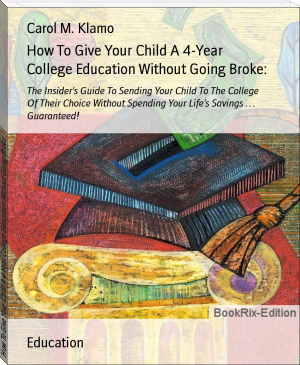How To Give Your Child A 4-Year College Education Without Going Broke: by Carol M. Klamo (best free ebook reader for pc TXT) 📖

- Author: Carol M. Klamo
Book online «How To Give Your Child A 4-Year College Education Without Going Broke: by Carol M. Klamo (best free ebook reader for pc TXT) 📖». Author Carol M. Klamo
* * *
Chapter #12
“5 Little-Known Secrets To Paying For College
If You Don’t Get Enough Financial Aid...”
In this chapter, we’re going to talk about innovative payment options just in case you didn’t get enough money for your child’s college education.
Or, if you’re the parent of a high school Junior, these payment options will help you to understand where to turn if the schools let you down and you still need more money for college.
Well, one thing’s for certain...
It’s Getting Tougher & Tougher To Get A Great
Financial Aid Package From Colleges These Days!
Why Is This?
To begin with, colleges and universities are receiving less money from the Federal and State governments. There is also a trend towards less FREE money and more loans being given out to help fund a college education.
All of these things have led to students receiving less money than they should be
entitled to under the financial aid formulas.
Some schools, particularly the private universities, have more flexibility when it comes to negotiating for a better financial aid package, while others, like state colleges, have very little room to do anything.
This means it is imperative for you as a parent to understand ALL of the payment options available to you just in case the college your child is dying to go to comes up short when awarding you financial aid.
So, without further ado...
Here Are The 5 Little-Known Secrets To Paying
For College If You Don’t Get Enough Financial Aid:
Secret #1:
Have Your Child Start Out At A State School And Then Transfer To A Private College.
If your child gets accepted to both private universities and state schools, and he/she prefers to go to one of the private schools - the first thing you need to look at is how much is it really going to cost you to send him/her to that school.
If the private university offers you an excellent package, which makes it approximately the same cost to you whether you send your child to private, or state - the answer seems pretty simple - send your child to their top choice.
If, however, the private university offers you a less-than-competitive package, and sending your child there will put you deep into debt, my recommendation is to think about sending him/her to a state school for two years, and then have them transfer over to a private university.
You will probably end up saving yourself about $30,000, and your child will end up with a diploma from a private university to boot.
However, I must caution you: If your son/daughter doesn’t plan to get top grades (A- or above) at the state school, they’re going to have a tough time transferring over to a top private university.
Also, schools tend NOT
to offer their best packages to transfer students.
Keep these things in mind before you opt to take advantage of this.
Secret #2:
Think About Sending Your Child To A College That Offers Cooperative Education.
About 900 colleges and universities across the country offer programs where students can alternate between full-time study, and a full-time job.
This differs from work/study in that work/study jobs tend to be part-time jobs that students work at for a couple of hours a day until they’ve earned the amount of the award.
On the other hand, cooperative education offers periods of full-time employment in jobs that the student is interested in pursuing after they graduate.
The student usually makes enough money to pay for a good portion of tuition, and they have a much better chance of landing a good job after they graduate.
The only downfall is it will probably take 5 years to graduate.
Secret #3:
Have Your Child Take The Military Route.
There are two different options here.
The first one is the Reserve Officer Training Corps. which has branches at many colleges. To qualify for an ROTC Scholarship which usually covers full or partial tuition plus $100 a month allowance, your child must apply in his/her senior year of high school. They should also have good grades and 1800 or above SAT scores.
The other option is applying to one of the service academies, which are extremely difficult to get into. To apply, your child must have excellent grades and SAT scores, pass a physical, and have a recommendation from a Congressman or Senator. If your child can get past all of the above, they will enjoy a FREE college education.
The only downside to going the military route is your child will be required to serve several years in the military after they graduate.
Secret #4:
Look Into Outside Scholarships To Help Pay For College.
True, private scholarships only make up 3.7% of all monies available for paying for college. But, you definitely won’t get any of this money if you don’t apply for it.
Caution
- Don’t just use any old scholarship search company or even worse internet searches that promise millions of dollars of unclaimed scholarships. Most of these search services are bogus and will charge you an arm and a leg for their service.
Secret #5:
Try Borrowing From An Innovative Loan Program.
Before you look into any type of loan programs, do your best to qualify for federally subsidized loans, which are interest-free and principal free until your child graduates.
If you still need to borrow more money, try looking into private alternative loans. Your college planner will have a list of reputable sources for these alternative loans.
You should also think about taking out a home equity loan or refinancing instead of a commercial loan since all of your interest payments may be tax deductible.
* * *
Your best bet is to consult your college planner. Chances are they have worked with many different family scenarios, all with unique special circumstances and have the ability to think outside the box on a solution that will fit your needs.
Chapter #13
"A Treasure Chest Of Tips To Beat
The High Cost Of College..."
I think you're really going to love this section!
Rather than covering just one strategy or technique to beat the high cost of college, I'm going to share with you...
“A Bushel Of Unusual Tips And Strategies to Beat The High Cost Of College!”
We have a lot to cover in this section, so without further ado - let's get started:
1. Choose Colleges That Have Innovative Payment Plans.
Don't only pay attention to the normal college search criteria like courses offered, academic and athletic reputation, geographic location, etc. Instead, make sure you inquire about special scholarships, installment plans, guaranteed cost plans, and tuition remission for good grades. Remember, if you don't ask - they won't tell!
2. Always Apply To, At Least, Two Or Three Schools That Are Rated Equally.
This way, if your child gets accepted to all of them, you may be able to play one against the other when negotiating to get a better financial aid package.
3. Try To Understand The Financial Aid Formulas.
By understanding the formula, you will start to see how different factors will affect your eligibility for financial aid. For example, “Should you move the assets out of your child’s name?” or “Should Mom or Dad take two courses at a local community college to qualify as a part-time student?” By knowing the formula in advance of applying, you can legally set up your personal and financial situation to maximize your eligibility for financial aid.
4. Send Your Child To A Community College For His/Her First Two Years Of School.
If your child works hard and gets good grades, they can usually transfer to a top private university. This way, they can get a diploma from a prestigious school for half the cost!
5. Check Out Your State’s Financial Aid Programs.
By contacting your state’s higher education agency, you can find out what financial aid programs they can offer “in-state” students. Many states have grant and low-interest loan programs specifically to help students who plan to pursue careers in medicine or teaching. Check with your state agency to see what they have for your child!
6. Don’t Say “No” To Subsidized Student Loans.
If you end up qualifying for either a Perkins loan or a subsidized Stafford loan, think very strongly about taking it! These loans are interest-free for the four years your child is in school and up to six months after they graduate. In effect, the government is picking up the tab on these loans for four entire years. You may even be able to borrow the money, gain interest on it for four years, and then pre-pay the loan after four years without paying any interest whatsoever. Check with your lender to find out.
7. Have Your Child Complete Four Years Of College In Three Years.
Your child will have to attend summer school, but you will save the 7 - 8% increase in tuition for the fourth year.
8. File Your Financial Aid Forms Accurately And On Time.
Remember, financial aid is awarded on a first come, first served basis. If you submit your forms with errors or omissions, it will probably “bump” the financial aid forms, and you will have to resubmit them at a later time. If this happens, you will probably lose aid since they award money on a first come, first served basis. Also, make sure to get your forms in on time. Most schools have different deadlines, and if you miss their deadline, you will almost definitely get less funding. The moral of the story is - File your forms correctly the first time!
9. Pick Colleges That Have The Best Histories Of Giving Good Financial Aid Packages.
Many schools publish statistics on how much “need” they meet and how much FREE money and loans they give out. Know these numbers before you apply, so you don’t waste time and money applying to schools you’ll never be able to afford.
10. Don’t Be Afraid To Appeal For A Better Financial Aid Package.
A school’s financial aid package is NOT fixed in stone. Just because they offer you a certain package, doesn’t mean you have to accept it. If you know how to calculate your “expected family contribution” and you find out what the school’s history of giving out financial aid is, you can usually get a pretty accurate idea of what you should have received. If the school’s offer is way off - write a letter to negotiate. I have seen many cases where schools gave $2,000... $3,000... even $6,000 more than they originally offered just because the family asked. The moral is - Don’t Be Afraid To Negotiate!
11. If You Can’t Afford To Pay Your “Expected Family Contribution”, Think About Taking Out A Home Equity Loan Or Line Of Credit.
By taking out a home equity loan instead of a commercial loan, your
 The desire to acquire knowledge about the surrounding world and human society is quite natural and understandable for a person. Life is so developed that an uneducated person will never occupy a high position in any field. Humanity in its mass, and each person individually, develops objectively, regardless of certain life circumstances and obstacles, but with different intensity. The speed of development depends on the quality of training.
The desire to acquire knowledge about the surrounding world and human society is quite natural and understandable for a person. Life is so developed that an uneducated person will never occupy a high position in any field. Humanity in its mass, and each person individually, develops objectively, regardless of certain life circumstances and obstacles, but with different intensity. The speed of development depends on the quality of training.




Comments (0)